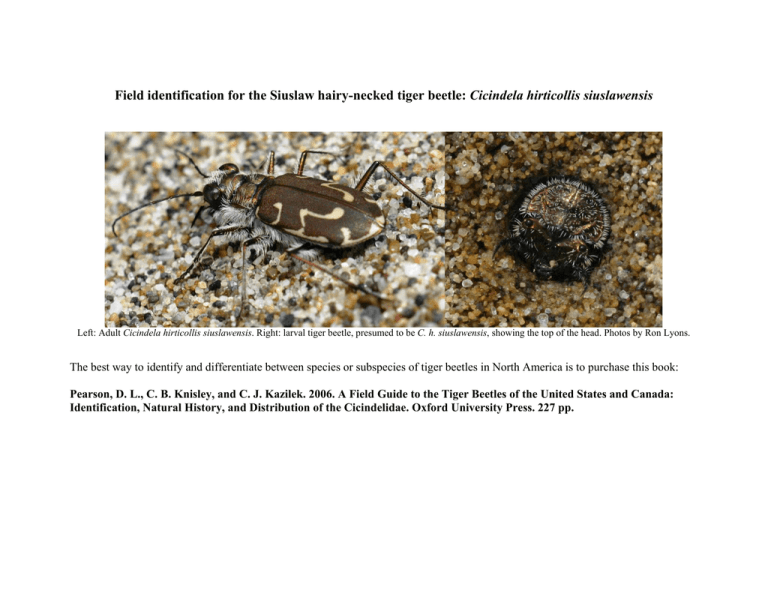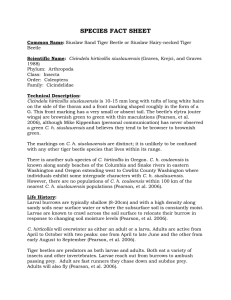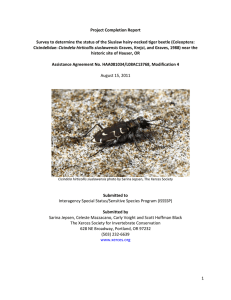Cicindela hirticollis siuslawensis
advertisement

Field identification for the Siuslaw hairy-necked tiger beetle: Cicindela hirticollis siuslawensis Left: Adult Cicindela hirticollis siuslawensis. Right: larval tiger beetle, presumed to be C. h. siuslawensis, showing the top of the head. Photos by Ron Lyons. The best way to identify and differentiate between species or subspecies of tiger beetles in North America is to purchase this book: Pearson, D. L., C. B. Knisley, and C. J. Kazilek. 2006. A Field Guide to the Tiger Beetles of the United States and Canada: Identification, Natural History, and Distribution of the Cicindelidae. Oxford University Press. 227 pp. Generalized tiger beetle illustration from Pearson et al. 2006 C. h. siuslawensis and similar-looking species with overlapping ranges Cicindela hirticollis siuslawensis Cicindela repanda Cicindela oregona Cicindela bellissima Cicindela tranquebarica © Ron Lyons © Chris Wirth, cicindelophile@gmail.com © Will Chatfield Taylor © Scott Nelson © Chris Wirth, cicindelophile@gmail.com Subspecies Cicindela hirticollis siuslawensis: “Above it is brownish green to green, the maculations are thin, and the rear hook on the front maculation is absent or quite small.” (Pearson et al. 2006) Subspecies C. repanda repanda: “Bronze-brown above with thin but complete maculations on the elytra that are usually not connected to each other. However, a few individuals in most populations exhibit an incomplete white connection along the outer elytra edge.” (Pearson et al. 2006) Species Cicindela repanda: “Length 11-13 mm; reddish to bronze-brown above, with three distinct maculations on each elytron that are connected to each other along the outer edge in some individuals and populations. The front maculation is in the shape of the letter C. Some populations have their Species Cicindela bellissima: “Length 12-13 mm; above brown with coppery reflections. The maculations are heavy but separated into three distinct lines. The middle line has a curved bend toward the rear but lacks the sharp “elbow” of other species, such as [C. oregona], with which it occasionally occurs… The brown upperparts of the thorax and head are more greenish in southern Oregon. Individuals that have completely green or blue above are present in small numbers at most locations.” (Pearson et al. 2006) Subspecies Cicindela tranquebarica vibex: “Above brown, green, or dull coppery green with thin maculations in which the first one is often reduced to a short line; metallic purple to green below.” (Pearson et al. 2006) Species Cicindela hirticollis: “Length 10-15 mm… a large tuft of long white hairs on the side of the thorax and the front maculation shaped roughly in the form of a G, with a forward hook on its Subspecies Cicindela oregona oregona: “The undersides are metallic blue or purple and the upperside of the head, thorax and elytra are the same color, usually dark brown but with some individuals showing green, blue, or rarely purple. The maculations are thin.” (Pearson et al. 2006) Species Cicindela oregona: “Length 11-13 mm.” Lacks a “distinct or Species Cicindela tranquebarica: “Length 11-15 mm… lack of extended white line running along the outer edge of the elytra, and, if present, the rear of the front maculation is a long, straight line angled away from bottom end…is only likely to be confused with [C. repanda], which lacks the large tuft of white hairs on the side of the thorax and has its front maculation in the shape of a C. Also, the mandibles of [C. hirticollis] are noticeably longer and thinner than those of [C. repanda].” (Pearson et al. 2006) Range: “Occurring only on the Pacific Ocean beaches at the mouths of rivers from the central Washington coast south to Eureka, California.” (Pearson et al. 2006) maculations reduced to dots and thin lines. The underside is metallic blue green to coppery and covered with short white hairs. The constrictions at the front and back of the thorax are similar in width…Another similar species, [C. hirticollis], has the front maculation with a distinctive hook at its rear end forming the letter G. [C. hirticollis] also has large tufts of white hairs on the side of the thorax that are absent or less obvious on [C. repanda].” (Pearson et al. 2006) Range: C. repanda repanda: “From the Atlantic Coast almost to the Pacific Ocean in Oregon, Washington and British Columbia.” (Pearson et al. 2006) remnant short white line running along the middle of the outer edge of each elytron and at right angles to the middle band…” Middle band on the elytra “has a sharp bend toward the rear that forms what is often referred to as an “elbow.”” (Pearson et al. 2006) Range: C. oregona oregona: “occurs from the Pacific Ocean inland to the Rocky Mountains.” (Pearson et al. 2006) Range: “Occurring only in coastal Washington to extreme northern California, this species is restricted to a narrow band of discontinuous sand dunes. The adults are most common in the dune swales and actively shifting dunes from the shoreline inland up to 2 km. Only dunes that are lightly vegetated or devoid of vegetation are occupied. Where the dunes are relatively close to the ocean shoreline, adults can also be found along the water’s edge. Growth of extensive vegetation and planting for dune stabilization produces unsuitable habitat for [C. bellissima].” (Pearson et al. 2006) C. h. siuslawensis paratype specimens at Oregon State Arthropod Collection. Photo by Sarah Foltz. the outer edge of the elytron and with a rear tip that is not expanded. The width of the maculations ranges from thick to thin or even absent in individuals of some populations. Its color below ranges from copper, metallic green, blue, and purple to almost black.” (Pearson et al. 2006) Range: “C. t. vibex occurs from western BC south to California… [Specimens west of the Cascades] occur in habitats such as: sea beaches, mud flats along lakes, ponds, streams, and irrigated pastures.” (Pearson et al. 2006) Seasonality of C. h. siuslawensis Active from April to October, peaking from April to late June and early August to September. The species overwinters in both the adult and larval form. (Pearson et al. 2006). In 2008, Ron Lyons observed adult C. h. siuslawensis from mid-April to mid-September on the Oregon Coast, but they started to be more abundant in late May. Larval biology of C. hirticollis “Burrows are restricted to sandy soils near surface water or where the subsurface soil is constantly moist. The density of these typically shallow burrows (8-20 cm) is often high along flood plains, overwash areas, and other low-lying water edge sites. The larvae of this species are unusual in that they are regularly found crawling across the soil surface to relocate their burrow in response to changing soil moisture levels.” (Pearson et al. 2006) Side view and cross section of a tiger beetle larva in its burrow (left), photo from arkive.org, and top view of tiger beetle larval burrows (right), photo from: http://flickr.com/photos/24608578@N00/2349008658.




